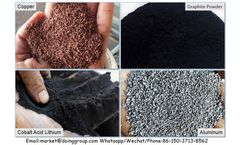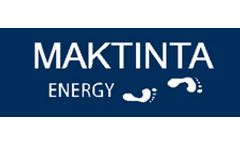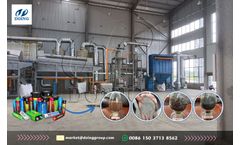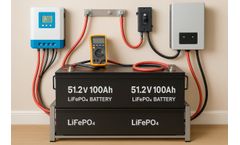Refine by
Energy Storage Articles & Analysis
382 articles found
Integrating biochar into treatment systems provides industries with an environmentally compliant pathway to reduce discharge loads while improving water recycling initiatives. Energy Storage and Carbon Materials The electrical and materials sectors have increasingly turned to biochar for advanced applications. ...
To increase the depot's energy resilience, MCRD installed a microgrid that combines several distributed generation sources in a hybrid approach. The microgrid has a 3.5 MW combined heat and power (CHP) system, a 5.5 MW of solar photovoltaic (PV) array, and a 4 MW battery-based energy storage system, together with an integrated control system ...
With the rapid development of new energy technology, lithium batteries are increasingly used as an important component of electric vehicles, portable electronic devices and energy storage systems. ...
This 2,560-square-foot off-grid commercial solar installation in California is a prime example of renewable energy solutions for factories and businesses looking for self-sufficient solar energy systems. Constructed from eight 40-foot container boxes, the facility is designed for versatility and sustainability, featuring a 720-square-foot medical lab, a full kitchen, showers, office space, a ...
The largest Refugee camp in Africa, located in Tanzania near the Burundi border and housing over 290,000 refugees from Burundi and Rwanda, we implemented an off-grid solar power system to enhance sustainability and efficiency. Our AgroTEK system automates the pumping of water from a local river into a storage tank, ensuring daily water quotas are met and maintaining optimal water ...
Round-trip efficiency: LFP systems commonly achieve round-trip energy efficiencies in the low 90s percent, higher than lead-acid, which reduces the required PV array size and increases usable energy per daylight hour. ...
Before transport for recycling, ensure packs are at a safe SoC (check local guidance) and terminals are insulated to prevent short circuits. 10) Practical differences: LiFePO₄ vs other lithium chemistries LiFePO₄ (LFP) cells are chemically more stable and tolerate higher temperatures and deeper cycles compared with some high-energy lithium chemistries. That makes them a bit more ...
Energy Storage: Batteries store surplus power to supply loads when the sun sets or wind dips. ...
Renewable sources—solar, wind, and hydropower—offer clean generation but suffer from variability: clouds, calm winds, or dry seasons can curtail output. Grid‑scale energy storage, therefore, is essential to smooth supply, shift excess generation to peak demand periods, and reduce reliance on backup fossil‑fuel plants. Why Lithium‑Ion? Among ...
With the explosive growth of India's electric vehicles and energy storage industries, the amount of scrapped lithium batteries is expected to exceed 500,000 tons in 2030, but traditional hydrometallurgical recycling technology is difficult to meet market demand due to high cost, high pollution and complex processes. ...
Four in parallel maintain 12V while summing capacity to 400Ah, yielding 4,800 Wh of nominal energy. However, usable energy must account for depth-of-discharge (DoD) limits and system inefficiencies. ...
In this detailed guide, we’ll walk through every step—from understanding your energy needs to selecting panel wattages—to ensure your system delivers consistent, efficient charging all year long. ...
A Professional Guide to Sizing, Wiring, and Maintaining Your Off-Grid Energy Storage System In an era where sustainable energy solutions are both accessible and necessary, building a DIY solar battery bank has never been more appealing. ...
Your Beginner’s Guide to Getting Started with Lithium Energy Stepping into the world of lithium batteries can feel like a leap into a sci-fi movie—power storage that’s compact, lightweight, and long-lasting sounds almost too good to be true. ...
The Low Pressure Metal Hydride Hydrogen Storage Bottle represents VET Energy's innovation in the field of hydrogen energy. It combines efficient energy storage and release solutions to provide users with a convenient and sustainable clean energy option. The smart design and efficiency of this ...
Summary Algae growth negatively impacts power generation efficiency by obstructing water flow, increasing maintenance costs, and causing potential revenue losses due to downtime. Real-time monitoring combined with non-chemical prevention strategies enhances algae management, ensuring efficient power generation and promoting the ecological health of aquatic ecosystems. Algae can significantly ...
SEM can show, for instance, the diameter, length and surface shape of doped carbon nanotubes. Electron Energy Loss Spectroscopy (EELS): EELS is used to study the electronic composition and defect states of carbon nanotubes. ...
Hybrid RTG: These cranes combine diesel engines with energy storage systems, such as lithium-ion batteries. The batteries store energy during operations, which can then power the crane during periods of low activity, reducing fuel consumption and emissions. ...
MXene Materials for Energy Storage Energy storage is a crucial aspect in modern society, given the increasing demand for portable electronics, electric vehicles, and renewable energy systems. ...
The most important components in a secondary battery are electrode materials, separators, and electrolytes. The main function of the electrolyte is to conduct ions to ensure that the ions move between the anode and cathode at a certain rate during the charging and discharging process of the battery to form the entire electrical circuit to generate current. As an important medium for ion ...











